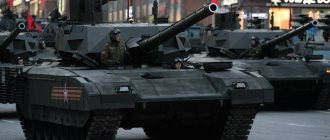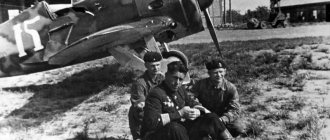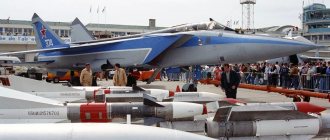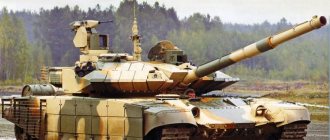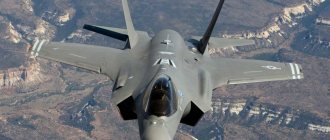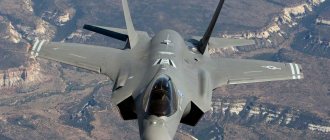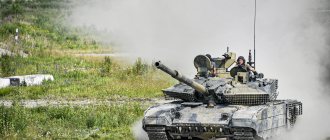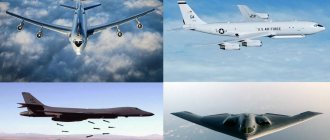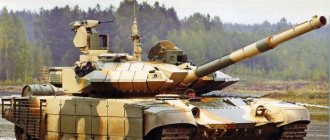For a long time, designers were worried about the idea: how to combine the best qualities of a helicopter and an airplane? Such a device could hover in the air, land on any platform of suitable dimensions - but at the same time fly faster than a helicopter and over long distances. The machine, later called a "convertiplane", could do this due to turning propellers.
Tiltrotor projects appeared even before World War II, prototypes began to be built in the post-war years. But only one model reached serial production - the American V-22 Osprey. Moreover, the experience of its operation still does not allow us to confidently judge whether the designers’ hopes were justified.
History of creation
She began building her first experimental tiltrotor in the 50s. The first XV-3 prototype took off in 1955, but the aircraft proved unstable and soon suffered an accident, after which it was written off. The second modified version of the XV-3 flew better, but did not show any noticeable advantages over helicopters.
In the 70s, the idea of a tiltrotor was turned to again - the army announced a competition to create an aircraft with a short takeoff and landing. , in collaboration with Boeing's helicopter division, built the XV-15. It was tested by pilots from combat units, who spoke generally positively about the vehicle. And already in 1980, the JVX program was launched, within the framework of which it was planned to provide all branches of the US armed forces with a transport tiltrotor.
By 1985, the technical requirements for the vehicle were formulated, the volume of purchases was determined, and the tiltrotor was given the name V-22 Osprey (Osprey).
The development was again entrusted to Boeing - the other participants in the program were not even able to provide projects.
The first samples of the V-22 were planned to be built in the late 80s, and deliveries to the customer began in 1992. The first promise was fulfilled - already in May 1988 one of the pre-production copies would have been built. However, unsuccessful ground tests constantly led to delays in the first flight.
Flights began only the following year. In 1990, the Osprey was considered promising enough to continue funding; in 1991, experimental vehicles began to lift loads on an external sling; the decision was almost made to launch it into series - but then the V-22 began to fall.
If in one case there were no casualties (except for the V-22 itself), then in the second disaster the entire test team, sent to conduct demonstration flights, was killed.
The prospect of closing the V-22 program became clear.
They pointed out that the Osprey never demonstrated any advantages over helicopters other than range and speed, but the complexity of its design, operating difficulties, growing weight and cost did not require additional demonstrations.
The army withdrew from the project, and only the Marine Corps still expressed a desire to have a tiltrotor. As a result, companies were allocated additional funds to increase reliability and reduce the weight of the device.
The tiltrotor had to be completely redesigned. The new models received the index MV-22B (Marine Corps version) and CV-22B (Air Force version). The modified Ospreys began to be assembled in 1995, and by 1999 they completed flight tests. But in 2000, two MV-22Bs undergoing military testing crashed. Since the investigation concluded that pilot error was to blame, the Osprey was nevertheless recommended for mass production and adoption.
Convertiplane CV-22B Osprey aviation special operations forces of the US Air Force
US Air Force Special Operations Aviation.
In the previous publication, US Air Force Special Operations Forces Aviation, we looked at the tasks and structure of special operations forces, and also got acquainted with the US Air Force special operations aircraft, created on the basis of the C-130 Hercules military transport. Today we will talk about the CV-22B Osprey tiltrotor aircraft, designed to support the operations of American special forces.
Convertiplane CV-22B Osprey
Creation and adoption of the Osprey tiltrotor
After the failure of the operation to free American hostages in Iran in 1980, the leadership of the US Defense Department expressed interest in an aircraft capable of vertical takeoff and landing and at the same time having a cruising flight speed and range comparable to the Hercules turboprop.
An aircraft combining the capabilities of an airplane and a helicopter, built under the JVX (Joint-service Vertical take-off/landing Experimental) program jointly by Bell Helicopter and Boeing Helicopters and named V-22 Osprey. Osprey - Osprey), first took to the air on March 19, 1989. The Osprey became the world's first mass-produced tiltrotor - an aircraft capable of vertical takeoff and landing (as helicopters do) and long-term high-speed horizontal flight, typical of conventional aircraft. Since the tiltrotor is not fully either a helicopter or an airplane, this affected its design and appearance. According to the layout, the Osprey is a high-wing aircraft with a twin-fin tail, equipped with two Rolls-Royce T406 turboprop engines located at the ends of the wings in nacelles that can rotate almost 98 degrees. The nacelles are rotated using a hydraulic drive with a screw mechanism. The propellers with three trapezoidal blades are interconnected by a synchronizing shaft that runs inside the wing. This shaft provides the possibility of controlled flight and landing of the aircraft using one engine. To reduce the size of the aircraft during parking, the wing rotates and the propellers fold. In order to reduce the weight of the structure, about 70% (5700 kg) of the device is made of composite materials based on carbon and fiberglass with an epoxy binder, which makes it about 25% lighter than metal.
From the very beginning, the turboprop aircraft program, which began in the first half of the 1980s, progressed with great difficulty and was repeatedly threatened with closure. This was due to the large share of fundamentally new technical solutions and the high accident rate of prototypes and first production copies. A big blow to the project was the refusal of the US Army to continue funding. Air force officials were also critical of the Osprey. The Marine Corps command insisted on further implementation of the program, which needed to replace the CH-46 Sea Knight helicopters, whose service life was coming to an end.
Operating ranges of the CH-46E helicopter and MV-22B tiltrotor
The main argument, despite the higher cost, was the greatly increased combat radius and approximately twice the flight speed in cruising mode, which made it possible to quickly transfer marines and cargo from the UDC to the landing zone.
After a series of accidents and disasters, most of the problems associated with the technical reliability of the Osprey were resolved, and in 2005 the Pentagon approved a production plan. In 2008, the US military department entered into a contract for the supply of 167 V-22 Osprey tiltrotors for a total amount of $10.4 billion. In 2013, the US Department of Defense decided to increase the number of purchased Ospreys to 458 units. Of these, 360 are intended for the USMC, 50 for the Air Force and 48 for the Navy. The cost of one CV-22B, adopted by the Special Forces Aviation Command in 2014, was $76 million.
Google Earthy satellite image: CV-22B at Kirtland Air Force Base
Operation of US Air Force CV-22B tiltrotors in combat squadrons
The first Osprey was assigned to the 58th Special Operations Wing at Kirtland AFB, New Mexico, on March 20, 2006. This machine was used to train pilots and crew members. On November 16, 2006, the US Air Force officially accepted the CV-22B in a ceremony held at Hurlburt Field, Florida. On October 4, 2007, the tiltrotor was used for the first time in a real search and rescue operation. On March 16, 2009, the Air Force SOF command announced that the first six CV-22Bs of the 8th Special Operations Squadron, based at Hulbert Field, are ready to carry out combat missions.
Google Earthy satellite image: CV-22B at Helbert Field airbase
In June 2009, Ospreys took part in a humanitarian operation in Honduras, delivering about 20 tons of food and medicine to remote villages. In 2009, the 8th Squadron's CV-22B deployed to Iraq, and in 2010 to Afghanistan. On July 3, 2014, CV-22B landed special forces of the Delta Force unit in the vicinity of a militant camp in eastern Syria, where, according to intelligence data, hostages were being held. The commandos eliminated the militants on the spot, but discovered that the hostages had been moved to another location and returned home empty-handed. In general, tiltrotors performed well in Iraq and Afghanistan. According to American data, the coefficient of their technical readiness did not fall below 0.6.
According to its characteristics, the CV-22B fully met the requirements of special operations forces. Especially unlike helicopters, it easily crossed mountain ranges, and its range turned out to be significantly higher, but at the same time it was more demanding on landing sites.
Design features and characteristics of CV-22V
In terms of weight and dimensions, the CV-22B is close to the heavy special-purpose helicopter MH-53J Pave Low III, which was withdrawn from service in 2008, but significantly exceeds it in speed and flight range.
The weight of the empty tiltrotor is 15,000 kg. Maximum take-off weight - 27,440 kg. The weight of the cargo on the external sling is 6140 kg, inside the cargo compartment - 9000 kg. Crew – 4 people. The cabin, measuring 7.37 x 1.53 x 1.3 m, with a volume of 24.3 m³, can accommodate 24 fully equipped paratroopers or 12 wounded on stretchers with accompanying medical workers. Service ceiling - 7620 m. Maximum speed in airplane mode - 565 km/h, in helicopter mode - 185 km/h. Wing span at the ends of the propeller blades is 25.78 m. Length with blades folded is 19.23 m. Width with blades folded is 5.64 m. Height along the fins is 5.38 m. CV-22B, used by the Air Force Special Forces Aviation, differ from the MV-22B purchased by the US Marine Corps, with more advanced avionics and an increased fuel supply. The basic version of the CV-22B avionics included TACAN, VOR/ILS and GPS navigation systems, VHF and HF radio communications equipment, identification systems and night vision equipment. The Osprey was designed using a "glass cockpit" designed for the CH-46X helicopter, which was not put into mass production.
Flight information is displayed on four color displays. The cockpit has a fifth display to display a map of the area. To support flights in terrain following mode, there is an AN/ARO-174 radar, which can also be used for mapping the earth's surface. Subsequently, the CV-22B avionics, designed to carry out secret missions over enemy territory, underwent significant improvements, the cabin equipment was modified and new software was developed.
Compared to the Ospreys supplied by the USMC, special operations forces tiltrotors have an increased fuel capacity. The fuel tanks of the MV-22B, designed primarily for the transfer of marines and cargo from amphibious assault ships, hold 6,513 liters of aviation kerosene, and a full refueling of the CV-22B tanks is 7,710 liters. In addition, the Osprey of the US Air Force MTR can carry three external fuel tanks with a capacity of 1628 liters each. For ferry flights, additional fuel tanks with a total fuel capacity of 7235 liters can be installed in the cargo cabin. The combat radius without air refueling is about 800 km. Ferry range - 3890 km.
Currently, the CV-22B can receive aviation fuel in flight from all US Air Force MTR tankers built on the basis of the C-130 turboprop. The ability to refuel from regular flying tankers of the US Air Force: KC-135, KC-10 and KC-46 was also confirmed.
CV-22B losses
Although after the Osprey was adopted into service in special-purpose aviation, all heavy MH-53 Pave Low helicopters were decommissioned and the MC-130 aircraft were partly replaced, the Air Force command had many complaints regarding the level of technical reliability and flight safety. From its very first test flights, the Osprey gained notoriety. In various flight accidents, 12 V-22s of various modifications were destroyed, killing 42 people. Four Ospreys were lost during testing, and the rest were lost after they were put into service. However, despite a number of serious incidents, the Air Force MTR irretrievably lost only two tiltrotors. On April 9, 2010, as a result of the fall of a CV-22B, 3 American military personnel and one civilian were killed, and 16 more Americans were injured. The cause of the disaster was blamed on the pilots' erroneous actions in conditions of poor visibility, loss of situational awareness and high rate of descent. On June 13, 2012, a CV-22B crashed as a result of pilot error in the vicinity of Eglin Air Force Base could not be recovered, but everyone on board survived.
Improved CV-22B performance and survivability
At the same time, the CV-22B used by special forces has repeatedly demonstrated good survivability. Thus, in December 2013, three tiltrotors used to evacuate American citizens in South Sudan were damaged as a result of small arms fire from the ground. Subsequently, after returning, 119 holes were counted in their hull, which led to damage to the fuel and hydraulic systems. Despite the damage to the CV-22B, they managed to continue their controlled flight. In order for the Ospreys to cover a distance of 800 km and land at Entebbe airfield in Uganda, they had to be refueled several times in the air from an MC-130N aircraft.
Based on the results of use in the combat zone, the US Air Force Special Operations Command required modifications to the CV-22B. To increase combat survivability. First of all, it was necessary to eliminate fuel leaks when the tanks were shot through and install ballistic protection for the cabin and the most vulnerable parts of the structure. In 2015, the first 16 US Air Force CV-22B MTRs were equipped with ballistic protection kits consisting of 66 cermet plates. At the same time, the mass of armor protection was 360 kg, with the cost of one set being $270,000. Due to the reduced payload and shortened flight range, it was decided to equip only Ospreys directly involved in combat operations with armor. The drop in flight data that occurred after the installation of the armor was partially compensated for by increasing the power of the AE-1107C engines by 17%. This was achieved thanks to the modernization of the turbine and fuel equipment, while simultaneously updating the software. As a result, cruising flight speed was increased from 446 to 470 km/h.
Equipping tiltrotors with weapons and equipment to counter air defense systems
For self-defense of the CV-22B when firing from the ground, various options for installing weapons were considered. Most often, the Ospreys that flew in Afghanistan and Iraq had 7.62 mm M240 machine guns (the American version of the FN MAG), as well as 12.7 mm single-barrel M2 and three-barrel GAU-19 mounted in the tail section.
The onboard gunner fires from an M240 machine gun mounted on a ramp
In order to increase strike capabilities, tests were carried out with the AGM-114 Hellfire ATGM, AGM-176 Griffin small-sized precision-guided aircraft ammunition and GBU-53/B guided bombs. BAE Systems proposed a modular remote-controlled weapon system IDWS using a six-barrel 7.62 mm machine gun installation GAU-2 V/A, serviced by a shooter who had at his disposal an optoelectronic sighting and search system with a night channel.
GAU-2 B/A machine gun mount under the Osprey fuselage
However, the IDWS weapon system did not prove itself in any way in Afghanistan. First of all, this happened due to the fact that the American command began to very carefully plan sorties, clear the territory where special forces landed and accompany the tiltrotors with attack helicopters and attack aircraft. In addition, by that time, the Taliban, having experienced the striking power of American combat aircraft, began to avoid open conflict. As a result, the main focus in reducing the vulnerability of the CV-22B was made on armoring and installing advanced passive defensive systems. The upgraded Ospreys operating in the interests of the Special Operations Forces are equipped with the AN/ALQ-211 broadband digital receiving equipment, which analyzes radio frequency emissions in a difficult electromagnetic environment and can drop dipole reflectors or use jammers to neutralize threats. To counter missiles targeting the thermal signature of the engines, heat traps and the AN/AAQ-24 Nemesis laser countermeasures system are designed.
Immediate prospects for the use of tiltrotors in the US Air Force
Although the number of Ospreys in the US Air Force is relatively small, they play a significant role in supporting the combat activities of special operations forces. The introduction of the CV-22B into service made it possible to retire the MC-130E Combat Talon I aircraft and MH-53 Pave Low helicopters. Convertiplanes have also noticeably replaced HH-60G Pave Hawk helicopters in search and rescue squadrons. It is planned that the faster, more promising CV-22C tiltrotors will operate in conjunction with the HH-60W helicopters, which are planned to replace the HH-60G. For in-flight refueling of MH-60 special forces helicopters and HH-60 search and rescue helicopters in the future, CV-22Cs should receive refueling equipment similar to that used on KC-130J aircraft. An increase in the flight, operational and combat characteristics of the modernized CV-22C should primarily occur through an increase in engine power by 25% and the use of more advanced avionics and weapons. To be continued…
Design
The layout of the Osprey tiltrotor is close to the typical layout of a cargo aircraft - a high-wing aircraft with two fins. The V-22 fuselage kit and its skin are made of carbon fiber. An on-board radar and a boom for mid-air refueling are located in the nose. The pilot's cabin has bulletproof glass. The main element of the V-22 instrument panel is four color multifunction monitors.
The cargo compartment has two side doors and a cargo hatch in the tail.
Folding seats with shock absorption are installed along the sides, and under the floor there are hooks for the external suspension of cargo. The Osprey's buoyancy in the event of an emergency landing is provided by sponsons with fuel tanks. The folding wings of the tiltrotor are molded from carbon fiber, and transmission elements and additional fuel tanks are placed inside them.
The V-22 control system is fly-by-wire; there is no mechanical connection with the steering surfaces and engine nacelles. Two AE-1107C turboshaft engines are placed in rotating engine nacelles; the rotation of the propellers is synchronized using a transmission consisting of gearboxes connected by shafts. The Osprey gondolas are rotated using hydraulic systems. Engine control is electronic. The center section houses the auxiliary power unit. The tiltrotor chassis is tricycle. The nose strut is controlled.
For operation at night, the Osprey is equipped with an infrared viewing system as standard. There is no built-in weaponry, but the V-22's tail ramp can mount a machine gun emplacement. Ventral machine gun pods (with 7.62 or 12.7mm machine guns) were tested.
Notes
- (unavailable link). Retrieved August 15, 2013.
- The Military Balance 2022, p.56
- The Military Balance 2022, p.52-53
- CYNTHIA MCFADDEN, WILLIAM M. ARKIN, TIM UEHLINGER.
.
NBC News
. NBC News (10/02/2017). - ↑. ejection-history.org.uk
. Retrieved November 17, 2022. - Harro Ranter.
. aviation-safety.net. Retrieved November 17, 2022. - Harro Ranter.
. aviation-safety.net. Retrieved November 17, 2022. - (March 3, 2016). Retrieved November 17, 2022.
- Harro Ranter.
. aviation-safety.net. Retrieved November 17, 2022. - Harro Ranter.
. aviation-safety.net. Retrieved November 17, 2022. - Harro Ranter.
. aviation-safety.net. Retrieved November 17, 2022. - . www.joebaugher.com. Retrieved November 17, 2022.
- (English). www.fbo.gov. Retrieved November 17, 2022.
- Harro Ranter.
. aviation-safety.net. Retrieved November 17, 2022. - (April 10, 2010). Retrieved October 19, 2022.
- (April 12, 2010). Retrieved October 19, 2022.
- Accident Investigation Board.
. UNITED STATES AIR FORCE (August 9, 2010). Retrieved November 17, 2022. - Harro Ranter.
. aviation-safety.net. Retrieved November 17, 2022. - (April 12, 2012). Retrieved November 17, 2022.
- . ejection-history.org.uk
. Retrieved November 17, 2022. - Harro Ranter.
. aviation-safety.net. Retrieved November 17, 2022. - . lostarmour.info. Retrieved November 17, 2022.
- John Pike.
. www.globalsecurity.org. Retrieved November 17, 2022. - . Retrieved October 19, 2022.
- Harro Ranter.
. aviation-safety.net. Retrieved November 17, 2022. - . lostarmour.info. Retrieved November 17, 2022.
- ↑
- ↑. Naval Safety Center (September 30, 2013). Retrieved November 17, 2022.
- Harro Ranter.
. aviation-safety.net. Retrieved November 17, 2022. - . lostarmour.info. Retrieved November 17, 2022.
- Harro Ranter.
. aviation-safety.net. Retrieved November 17, 2022. - (May 18, 2015). Retrieved November 17, 2022.
- (unavailable link) (May 21, 2015). Retrieved November 17, 2018.
- (May 21, 2015). Retrieved November 17, 2022.
- (English). www.airfighters.com. Retrieved November 17, 2018.
- Harro Ranter.
. aviation-safety.net. Retrieved November 17, 2022. - . lostarmour.info. Retrieved November 17, 2022.
- (December 14, 2016). Retrieved November 17, 2022.
- (December 16, 2016). Retrieved October 19, 2022.
- Harro Ranter.
. aviation-safety.net. Retrieved November 17, 2022. - . lostarmour.info. Retrieved November 17, 2022.
- Harro Ranter.
. aviation-safety.net. Retrieved November 17, 2022. - . lostarmour.info. Retrieved November 17, 2022.
- Ben Doherty.
(English). the Guardian (6 August 2017). Retrieved November 17, 2018. - (August 5, 2017). Retrieved November 17, 2022.
- (August 5, 2017). Retrieved November 17, 2022.
- . lostarmour.info. Retrieved November 17, 2022.
- (unavailable link). Rpt No:AV-201
. Naval Safety Center (February 12, 2018). Retrieved November 17, 2022. - Harro Ranter.
. aviation-safety.net. Retrieved November 17, 2022. - . lostarmour.info. Retrieved November 17, 2022.
- ↑
Modifications and combat use
The two versions of Osprey produced in parallel - MV-22B and CV-22B - differ from each other mainly in equipment. The CV-22B has additional tanks in the wing, a multi-mode radar that allows flights in the “terrain following” mode, and additional radio stations are installed on it to maintain communication with the landing force and a tactical terminal.
Since 2007 and 2009, Marine Corps Ospreys have been used to transport cargo and troops in Iraq.
Air Force tiltrotors participated in exercises in Mali in 2008, and in 2014 they were used in Syria to transport special forces on missions. V-22s are periodically deployed for humanitarian missions to deliver aid to disaster areas or to evacuate American citizens from unstable areas.
Disasters and accidents
- June 11, 1991 - YV-22A (s/n 163915) crashed 3 minutes into its first demonstration flight in Delaware.
- July 20, 1992 - V-22 (s/n 163914) crashed into the Potomac River in Virginia during a demonstration flight in front of congressmen. 7 people died.
- April 8, 2000 - MV-22B (s/n 165436/MX-04), assigned to the USMC, crashed while landing at Marana Airport in Arizona due to engine failure at an altitude of 75 meters. 19 people died. Also damaged in the explosion was MV-22 (s/n 165433/MX-01), which was later written off.
- December 11, 2000 - MV-22B (s/n 165440/GX-08), assigned to the USMC, crashed into the forest near Jacksonville due to hydraulic failure. 4 people died.
- March 27, 2006 - MV-22B (s/n 166389/GX-16), assigned to the USMC 204th Medium Tiltrotor Training Squadron, collapsed during engine startup after a routine check. Decommissioned into a training model.
- April 9, 2010 - CV-22B (s/n 06-0031), assigned to the US Air Force, crashed 11 km from the city of Qalat in the Zabul province of Afghanistan, while performing a combat mission. The cause of the fall was a technical malfunction. 4 people died.
- On April 11, 2012, an MV-22B (s/n 165844/EM-11), assigned to the USMC, crashed southwest of the city of Agadir in the province of Morocco. The crash occurred after takeoff from a landing ship during joint military exercises between the United States and Morocco. As a result of the plane crash, two people were killed and two were injured.
- June 13, 2012 - CV-22B (s/n 06-0032), assigned to the 8th Special Operations Squadron of the US Air Force, crashed at an air base in Florida while performing a training flight. Five crew members were injured.
- June 21, 2013 - MV-22B (s/n 166735), assigned to the USMC, was destroyed by fire on the Atlantic coast of the United States, as a result of grass fire at the landing site. No injuries were reported.
- August 26, 2013 - MV-22B (s/n 168241), assigned to the USMC, was destroyed by fire that resulted from a hard landing near an air base in Nevada. The crew of 4 managed to leave the aircraft before it caught fire and were not injured.
- October 1, 2014 - MV-22B (s/n 168234/YP-03) made an emergency takeoff from a landing ship in Bahrain. The tiltrotor was launched into maintenance mode, in which the engine power was insufficient for stable flight, but was successfully landed. 1 crew member drowned after jumping from the tiltrotor.
- May 17, 2015 - MV-22B (s/n 168020/YR-01), assigned to the USMC, crashed while landing on the island of Oahu in the state of Hawaii. The tiltrotor suffered damage to the fuselage and caught fire. The accident resulted in the death of 2 US Marines and the injury of 20 others.
- December 13, 2016 - MV-22B (s/n 168027/EP-06), assigned to the USMC, crashed 6 km east of the city of Nago in Okinawa Prefecture, Japan. All five crew members were rescued, two of them were injured.
- January 28, 2017 - A USMC MV-22 made a hard landing and was subsequently destroyed during the evacuation of a US Navy Special Forces team in Al Bayda Governorate of Yemen. One person died and four were injured.
- August 5, 2022 - MV-22B (s/n 168634/EP-13), assigned to the USMC 265th Medium Tilrotor Squadron, crashed while landing on an amphibious transport dock off the coast of Australia. There were 26 people on board the tiltrotor, 23 of them were rescued.
- September 28, 2022 - MV-22B (s/n 168281/YP-01), assigned to the USMC, crashed in Syria. 2 Americans were injured.
November 9, 2022 - Japanese Cabinet Secretary-General Yoshihide Suga demanded that the United States ensure an adequate level of safety for the Osprey tiltrotor aircraft used by the American Marines amid reports that they have a high accident rate.
Flight performance
The V-22 Osprey continues to be the only one in its class. The civilian tiltrotor AW609 has not yet been certified.
Unmanned tiltrotors are being developed in Russia, but they have not yet left the development stage.
| MV-22B | |
| Wingspan, m | 14 |
| Maximum take-off weight, t | 23,8 |
| Cruising speed, km/h | 446 |
| Ferry range, km | 3690 |
| Combat radius, km | 722 |
| Load capacity, t | 9 (inside), 6.8 (on external suspension) |
Despite the fact that the Osprey is a very complex and high-tech machine, its parameters do not amaze the imagination. Sometimes it was even ironically called a hybrid of “a mediocre airplane with a mediocre helicopter,” which in no way justifies the cost.
However, in recent years, several countries have become interested in the V-22, and Japan has already placed an order (remember that at one time it was the Japanese who objected to the deployment of the Osprey). And the Russian convertoplanes being developed indicate that the idea is not so hopeless.
The designers of the V-22 Osprey managed to do a difficult job.
They were required not only to launch into production an aircraft, the like of which had not been built before (before that there were only experimental tiltrotors), but also to eliminate in advance all the inevitable “childhood diseases” of the design. As a result, they managed to accumulate significant experience, and the Osprey proved that the tiltrotor aircraft of the future are quite real.
Project evaluation
The V-22 Osprey is one of the most controversial and controversial aviation projects of recent decades. On the one hand, the designers managed to complete the task assigned to them. The Osprey can land and take off like a helicopter and perform horizontal flight like an airplane. But what did it cost them!
The project took almost twenty-five years to complete, tens of billions of dollars were spent on it, and people died in numerous disasters. Even today, the reliability of the Osprey is highly controversial. In addition, the tiltrotor is very complex and expensive to maintain, and the engine life is only 200 hours.
On the other hand, it became clear that the military needed such a machine. Perhaps that's why Bell and Boeing recently unveiled their next-generation tiltrotor, the Bell V-280 Valor. One can hope that the experience gained during the creation of the Osprey will help the designers avoid mistakes and shortcomings this time.
Disasters and accidents
- June 11 - V-22 (5th prototype), during factory tests, the gondola hit the surface of the earth while maneuvering at a height of 4.5 meters and caught fire.
- July 20 - V-22 (4th prototype) fell into the Potomac River during a demonstration flight in front of congressmen. 7 people died.
- April 8 - MV-22B (serial number 90014, 1st Squadron US Navy) crashed while landing at Marana Airport due to engine failure at an altitude of 75 meters. 19 people died. The explosion damaged MV-22 (serial number 90011), which was later written off.
- December 11, 2000 - MV-22B (serial number 90018, USMC 204th Training Squadron) crashed into the woods near Jacksonville due to hydraulic failure. 4 people died.
- March 27 - MV-22B (serial number D0056, USMC 204th Training Squadron) disintegrated during engine startup after a routine inspection. Decommissioned into a training model.
- April 9 - CV-22B Osprey (serial number 06-0031, 8th Special Operations Squadron, 1st Special Operations Wing, US Air Force) - crashed in Afghanistan 11 km from the city of Qalat in Zabul province while performing a combat mission. The cause of the fall was a technical malfunction. 4 people died.
- On April 11, a V-22 Osprey tiltrotor (serial number D0030, 261st Squadron of the US Marine Corps) with American Marines on board crashed in southern Morocco. As a result of the plane crash, two people were killed and two were injured. The crash occurred during the joint US-Moroccan military exercise African Lion.
- June 13, 2012 - MV-22B Osprey (1st Special Operations Wing, US Air Force) - The tiltrotor crashed in Florida at 16:45 while performing a training flight. Five crew members were injured.
- June 21 - MV-22B Osprey (serial number 166735, USMC 365th Medium Tilrotor Squadron) - completely destroyed by fire at an undisclosed location on the Atlantic coast of the United States, as a result of grass fire at the landing site. The fire spread from the grass to the fuselage. No injuries were reported.
- August 26, 2013 - MV-22B Osprey (serial number 168241, USMC 163rd Medium Tilrotor Squadron), Nevada - destroyed by fire after a hard landing near Creech
in Indian Springs during a training flight. The crew of 4 people were not injured and managed to leave the aircraft before it caught fire. - October 1 - MV-22B (serial number D0184) crashed while taking off from a ship in Bahrain. 1 crew member drowned after jumping from the tiltrotor.
- May 17, 2015 - MV-22B Osprey (serial number D0150) made a hard landing during a training exercise in the US state of Hawaii. The incident occurred near the air base on the island of Oahu at 11:00 local time (23:00 Moscow time). The MV-22 Osprey, belonging to the 15th Marine Expeditionary Unit, was carrying 21 people, including 15 Marines and four crew members. As a result of the accident, two people died and the rest were taken to the hospital.
- On December 14 of this year, on the Japanese island of Okinawa, a tiltrotor MV-22B (registration number 168027) made an emergency landing. Five crew members were rescued, two were injured.
- January 29 - During the evacuation of a US Navy special forces group in Yemen, one of the tiltrotors was severely damaged and was subsequently destroyed.
- August 5, 2022 - US Navy MV-22B Osprey (registration 168634/EP-13) crashed off the coast of Australia. There were 26 people on board the tiltrotor, 23 of them were rescued.
- September 29, 2022 - A US Navy V-22 crashes in Syria. 2 Americans were injured.
- November 9, 2022 - Japanese Cabinet Secretary-General Yoshihide Suga demanded that the United States ensure an adequate level of safety for the Osprey tiltrotor aircraft used by the American Marines amid reports that they have a high accident rate.
